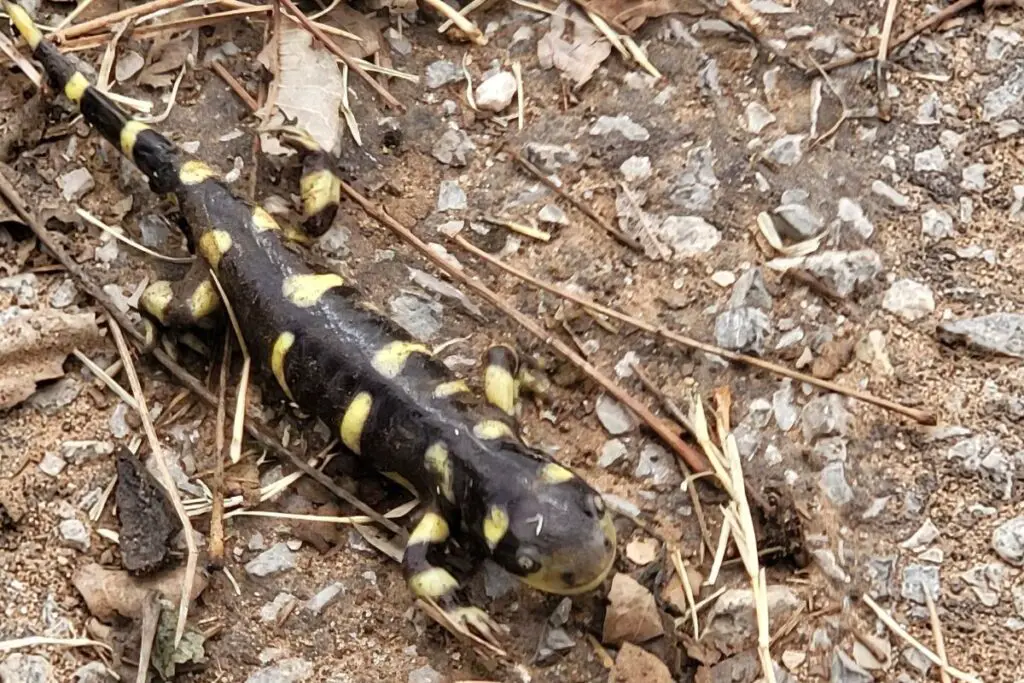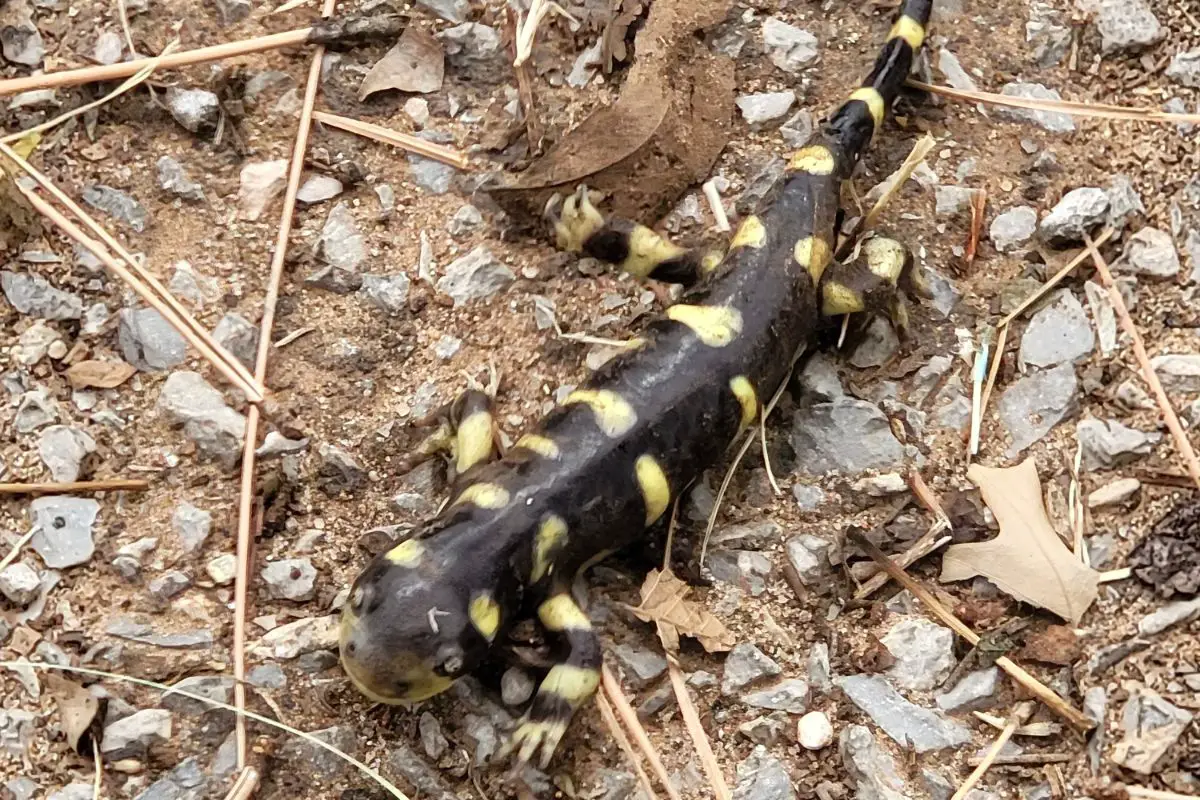The salamander (Caudata), or, as it was known in ancient times, that which lives in fire, or “fire lizard,” is actually not a lizard at all. It’s an amphibian, like a frog, although we can’t blame the ancients for thinking the salamander was a lizard. They do look pretty similar. However, while they share some similarities, their differences help us classify them better as amphibians.
While we know that salamanders don’t really live in fires or actually come from the fire itself, as many people believed in ancient times (Adeline), their reputation as poisonous to fruits and water does have some basis in truth. As some legends state, salamanders were so toxic that twining around a tree or climbing across the fruit could poison and kill anyone who ate it. It was also said that a salamander that fell into a well could kill anyone who drank from it (White 183-184).
How Poisonous are Salamanders?
Salamanders are not venomous, but they are poisonous, meaning they don’t inject venom into their prey or threats. They rarely bite unless highly threatened and would rather run and hide from danger. However, granular glands in their skin produce repellent or even toxic secretions that can cause those who come into contact with their skin to become ill or die (depending on the level and method of contact).
What are Salamanders?
Salamander is the name for an entire group of amphibians, including salamanders, newts, and sirens. They look like a lizard; instead of dry, hard scales, salamanders have smooth, moist skin like frogs and long tails like lizards. A newt is a salamander that spends most of its time on land. A siren is a salamander with lungs and gills that never develops beyond the larval stage. Salamanders are usually small. Very few are more than 6 inches long. However, a few, like the Chinese giant salamander, can reach sizes of up to 6 feet long and 145 pounds.
Salamander Skin
Salamander skin, like other amphibians, is thin and permeable to water, which allows their skin to stay moist and allows them to breathe. Glands in the skin also help keep the skin moist, which helps protect them against bacterial infections and mold, helps them swim, and makes them slippery to keep them from being caught by predators. The parotoid glands (enlarged areas behind the head) secrete toxins through the skin, while the granular glands can spray the toxin onto the predator. Some, like the fire salamander, can direct its spray toward a predator up to 30 inches away.
Skin Coloration and Toxicity
Salamanders are relatively slow-moving animals, perfect prey for raccoons, snakes, weasels, and owls. Their toxins help them defend themselves from predators. Alongside their toxins, some salamanders, such as the Hellbender salamander or mud puppy, have colors that will help them blend into their environment. Others display aposematic colors or colors that warn predators that they are toxic to eat, as well as secreting the toxins through their skin, such as the European fire salamander and the Red Salamander.
Why Shouldn’t You Touch Salamanders?
Although salamanders are small, docile, often cute amphibians that can be found nearly everywhere in the world, handling them could be dangerous to both humans and the salamander. Their skin is sensitive to human touch, could carry diseases and toxins, and salamanders are easily stressed out by handling.
Human touch can irritate salamander skin, damaging the protective mucus layer that helps regulate their temperature and absorb water. Besides the toxins salamanders secrete through their skin, they can also carry fungal infections, bacteria, and parasites that can be transferred through contact with their skin.
Handling salamanders can also cause stress to the salamanders’ appetite and immune system, which could lead to decreased activity and appetite. Furthermore, rough handling or handling them too often can cause physical injuries, like broken bones or torn skin, which would need veterinary care to heal.
If you must handle a salamander, it is best to handle them with gloves or some other instrument (I recommend tongs or tweezers). If you cannot use these things, thoroughly wash your hands and avoid rubbing your eyes or touching your mouth to prevent irritation after handling a salamander.

Symptoms of Salamander Toxins/Poison?
Because the toxins salamanders secrete or spray are neurotoxins, the first effect of contact is usually a local anesthetic effect or numbness to the area. However, prolonged exposure eventually would have the toxin affect the central nervous system, specifically the spinal cord. This toxin generally causes convulsions, high blood pressure, and respiratory paralysis. Usually, unless you eat the salamander, or forget to wash your hands after handling them, there is no threat to humans.
The most common toxin found in the skin, muscles, and even internal organs of some newts and salamanders is tetrodotoxin (TTX), which can, if ingested, cause a severe reaction, including a burning sensation, then numbness and tingling on the lips and tongue, followed by dizziness and a “pins and needles” sensation in the face, hands, and feet. This toxin is often accompanied by headache, nausea, vomiting, diarrhea, and loss of muscle control.
In more severe cases, the toxin can cause ascending paralysis, respiratory issues, changes in mental states, convulsions, irregular heart rhythms, and low blood pressure, leading to coma and death. These are only the most extreme cases, however, and most exposures to the toxins in salamanders cause a mild skin irritation or local anesthetic effect (Postma).
Are Salamanders Poisonous to Dogs/ Cats?
The majority of salamanders have less toxic levels than others. However, because dogs and cats are technically predators of a salamander, even if they are only curious about them and don’t necessarily want to eat them, salamanders can be poisonous to a dog or cat.
Most salamanders, like the red-backed salamander, will only give them a foul taste in their mouth as a warning– “Don’t eat me!” and react with a lot of drool. Still, some could cause a more severe reaction, such as the fire salamander or the rough-skinned newt, which have more lethal toxins if ingested in large enough quantities.
Some symptoms to look out for if you suspect your dog or cat has been poisoned by a salamander are:
- Excessive drooling
- Foaming at the mouth
- Diarrhea
- Vomiting
- Irregular heartbeat
- Elevated body temperature
- Difficulty breathing
- Seizures/convulsions
- Dilated pupils
- Erratic movement (Moving as though drunk)
- Loss of appetite
- weakness
- Excessive pawing at the eyes or mouth,
- Crying or whimpering
The severity of poisoning will depend on many factors, such as the type of salamander, the weight and health of the dog/cat, and the kind of dog or cat. Poison is not the only issue a dog or cat could face if they ingest a salamander.
They could also ingest bacteria, like salmonella, or parasites on the skin or in their bodies. Because salamanders often live in muddy, dirty, or unsanitary conditions, they can carry roundworms, tapeworms, flukes, or other parasites.
If your dog or cat catches or eats a salamander, it’s always a good idea to take it to the vet, no matter the toxin level they ingest.
Where Can I Find Salamanders?
Salamanders are usually found in shady forest areas, usually under a log or in a burrow they have dug. Some will even seek out a pool of water, like a pond or lake, to lay their eggs in or to keep their skin moist. But others, like the axolotl, will spend their entire life in the water. Here is a handy chart that shows some of the most common salamanders in the United States, how poisonous they are, and where to find them.
| Type of Salamander | How toxic they are | Where they are found | |
| Rough-skinned Newt | Extremely Poisonous | Northern California, Oregon, Washington, and southern Alaska | |
| Red-bellied Newt | Extremely Poisonous | Northern California | |
| Sierra Newt | Extremely Poisonous | Sierra Nevada | |
| California Newt | Extremely Poisonous | Coastal Range of California | |
| Eastern (red-spotted) Newt | Extremely Poisonous in juvenile red-eft stage, and mildly poisonous as adults | Eastern North America, from the Canadian Maritime Provinces, all the way to Florida | |
| Fire Salamander | Extremely Poisonous | Southern and Central Europe | |
| Tiger Salamander | Mildly Poisonous | Most of the United States and into Southern Canada | |
| Spotted Salamander | Mildly Poisonous | Eastern Canada, into the Eastern and midwestern United States. | |
| Marbled Salamander | Mildly Poisonous | Most of the Eastern United States | |
| Red Salamander | Mildly Poisonous | Most of the Eastern United States, as far north as New York | |
| Mud Salamander | Mildly Poisonous | Most of the Eastern United States, with one isolated population in Mississippi | |
| Slimy Salamander | Mildly Poisonous | Most of the Eastern and Central United States, from Florida, all the way to Oklahoma | |
| Red-backed Salamander | Very Mildly Poisonous | Most of Eastern North America, from Missouri all the way to the Canadian Maritime Provinces | |
| Long-toed Salamander | Very Mildly Poisonous | Most of the Pacific Northwest region of North America |
Conclusion
Salamanders are awesome creatures, however, as we mentioned, they can pose a threat to small animals like dogs and cats. As long as you take precautions like washing your hands and handling them correctly, they pose little threat to you.
I have helped salamanders cross the road by using a tree limb, when I didn’t have anything else to use. Are salamanders poisonous? Yes. Are they a huge threat to humans that handle them correctly, No.
Want to learn about other animals from nature’s kingdom?
Check out:
Sources
Adeline, Genevieve. “Myth and magic – historic insurance emblems.” Chartered Insurance Institute. https://www.cii.co.uk/news-index/articles/myth-and-magic-historic-insurance-emblems/46567#:~:text=These%20beliefs%20are%20thought%20to,magically%20appeared%20in%20the%20fire. Accessed 10 July 2023.
Bargahzi, Benedetta, et. al. “Factors determining the dorsal coloration pattern of aposematic salamanders.” Scientific Reports 12:17090 (2022). https://www.nature.com/articles/s41598-022-19466-0#citeas
Brodie, Jr., Edmund D. and Neal J. Smatresk. “The Antipredator Arsenal of Fire Salamanders: Spraying of Secretions from Highly Pressurized Dorsal Skin Glands.” Herpetologica. 46:1 (Mar. 1990), pp 1-7.
Postma, Terri L. “Neurotoxic Animal Poisons and Venoms.” Clinical Neurotoxicology. Elsevier: 2009. 463-489.
“Salamanders.” Amphibian Planet. 11, July 2023. https://amphibianplanet.com/category/salamanders/
White, T. H. The Book of Beasts: Being a Translation From a Latin Bestiary of the Twelfth Century. Alan Sutton: 1992.
- Miraculous Reunion: Family’s Missing Dog Returns After 12 Years - February 25, 2024
- Do Turtles Have Tails - February 11, 2024
- Do Turtles Have Scales? An Overview - February 10, 2024


